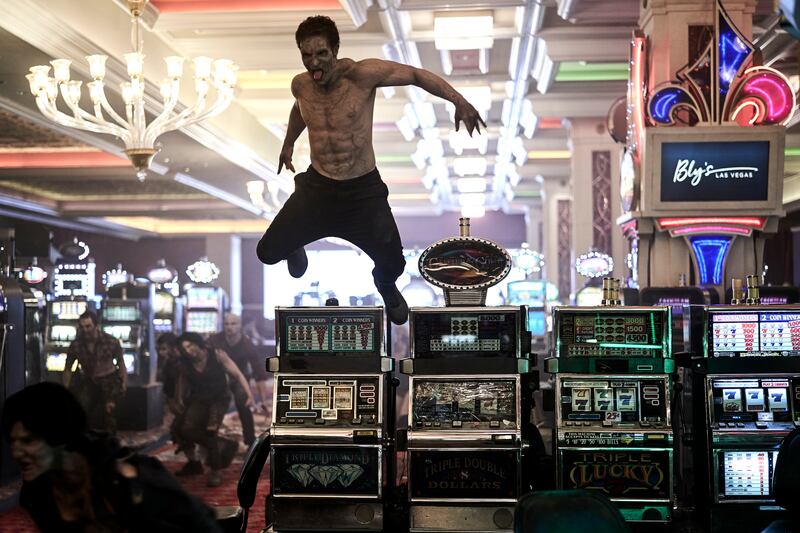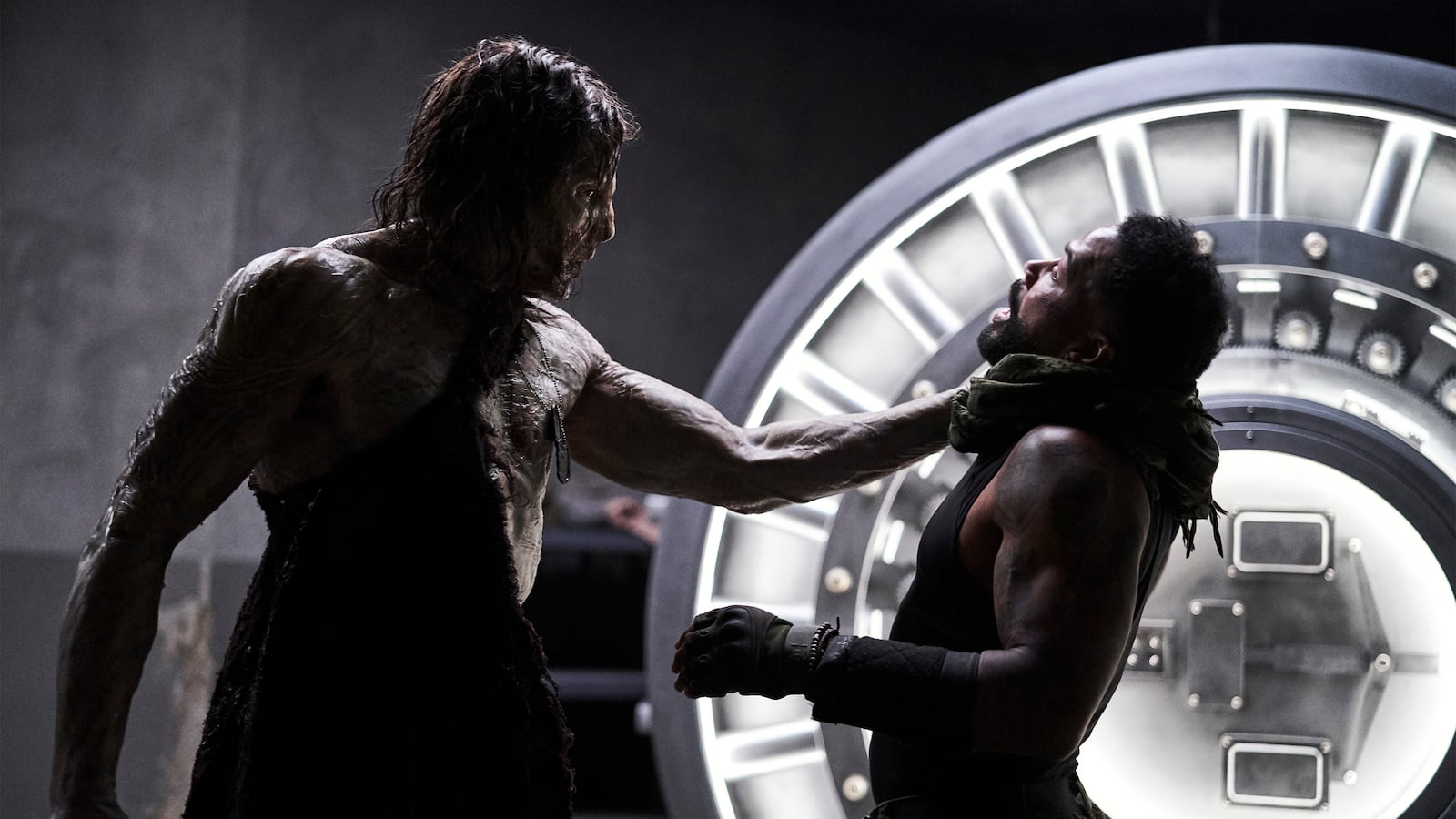What do audiences want out of a zombie movie?
Is it stirring, character-driven plots about blood, family, and sacrifice? A sharp-toothed satire aimed at the mindlessness of modern society? A subversion of genre tropes, maybe, into a winking variety show juggling horror, humor, and romance? Maybe a musical?? Would the people, perhaps, be into a cameo from Sean Spicer?
The latter, I’m pretty confident, is the rottenest little dash of flavor in the cannibal recipe of late. (Though maybe it isn’t the most puzzling: People have noted since his days behind a podium lying to the press on the president’s behalf that ex-White House press secretary Spicer looks like the guy in a zombie movie who won’t tell you he got bit until it’s too late.) Army of the Dead, director Zack Snyder’s second entry in the zombie canon, tries just about every other spice, too, in its attempt to serve up something fresh. Some of it is irresistible. A lot of it falls flat. But before you ask, no, Spicer doesn’t get mauled alive by undead hordes.
There are so many missed opportunities in this movie.
Chief among them might be jettisoning the living flesh bags entirely, as no human character here approaches the fascinating presence of their enemies: a king and queen of the dead who ride atop desiccated horses, command hulking armies from inside a Las Vegas casino, and skulk around their desert kingdom with a lethal, loping grace. They even each have a discernible sense of style, she in her glittering goth-showgirl regalia and he in a protective steel headpiece and tattered cape. In place of the other characters’ stilted dialogue and comedic flat-liners, these two just hiss and roar and purr at each other monstrously. They’re perfect.
The king and queen are the highest-ranking of the “alpha” class of zombies—a smarter, more organized, more nightmarish strain than your average ghoul—and one of the movie’s most striking innovations. I wish Army of the Dead were just about these two; who knows, it might have succeeded as a black-hearted romance more than as the stuttering rehash of Aliens it slowly, inexplicably wills itself into becoming. (Keep Tig Notaro in the aviators with the cigar, though. Just two lovestruck zombies and Tig.)
What we get instead, after a winning opening sequence, is a cumbersome melodrama and empty, splattery fun. Which is fine enough for a mindless Netflix night in. But Army of the Dead so often seems on the verge of having something more to say about the world we live in today and the ways we’ve responded to crisis. Then right when you’re leaning in to listen, it explodes a brain. Or worse, hands the mic to Sean Spicer.
A zombie outbreak in the Nevada desert turns Sin City into hell in the movie’s opening, launching a darkly funny bacchanal of destruction on the Strip. To the tune of a Liberace impersonator’s jaunty cover of “Viva Las Vegas,” Snyder revels in the city’s signature hedonism gone awry. Topless showgirls devour satin-robed men alive. Bachelorettes descend like banshees on the slots. A dazed Elvis shuffles into the early morning light after a seemingly wild night—evidenced by the blood dripping from his mouth. Snare drums burst in time with machine-gun fire, and lyrics like “if I wind up broke” and “one-arm bandits crashin’” find wryly grim new meanings.
The musical montage swallows up the conventional start to a story like this, where the human resistance makes its last stand. Instead, we see just flashes of the carnage and human toll as the song ascends into an elegy sung by Snyder favorite Allison Crowe. When the sequence ends, a wall has been erected around the perimeter of Las Vegas to keep the dead contained, Escape From New York-style. Several years blur by. And as the camera pans up to a breathtaking panorama of a broken Las Vegas skyline and a Strip overrun by death, the visual joke tells itself: What dies in Vegas, stays in Vegas.
The sequence is a lot of fun and an effective reminder of Snyder’s unimpeachable strengths as a director (though he kindly refrains from laying on too much of the slow-mo this time). The story that unfolds is in the signature Snyder style, too. It reveres mythology and Joseph Campbell. It’s full of audacious, on-the-nose needle drops (its use of the Cranberries’ “Zombie” here is so brazen, you have to respect it). And it roots for a central group of rag-tags who band together against innumerable enemies. Plus, a number of self-references to his 2004 Dawn of the Dead remake. You liked that zombie baby last time around? Get ready for a zombie fetus!
It also gestures at politically-charged imagery in a plot that somehow lands nowhere in particular. A “quarantine camp” outside the Vegas perimeter seems to hold people indefinitely, supposedly out of concern they may be infected. Hmm, you think. Seems bad. Suddenly we’re ambushed with Sean Spicer’s face as he debates Donna Brazile on some cable network. He argues that detainees should be “grateful” for the camps’ “free health care solution.” Brazile counters that the camps are unnecessary since no one has emerged from them infected, and claims they are being used to turn liberals into political prisoners. Spicer purses his lips into a weird little smile. You, at home, scream.
This plays out on a TV in the background as our main character, Scott Ward (Dave Bautista), decides whether or not to take a billionaire up on his once-in-a-lifetime offer. If he agrees to stage a heist and help crack open a safe in the heart of infected Las Vegas, he takes home a cool $50 million. That’s worth more than the Medal of Honor he took home for his heroism in the zombie wars, and it’s enough to keep him from flipping burgers for the rest of his life. He’s in.
Next up is assembling a crew of mostly working-class folks: a car mechanic (Ana de la Reguera), a helicopter pilot/mechanic (Tig Notaro, green-screened in to replace Chris D’Elia, who was accused of violating child pornography laws last year), a locksmith (Matthias Schweighöfer), an old war buddy who’s great with a buzzsaw (Omari Hardwick) and uh, a YouTuber (Raúl Castillo)? “There are Reddit forums devoted to this guy,” we are told. His buddy Chambers (Samantha Win) tags along, done up in a red bandanna and military-issue tank top in an explicit reference to Vasquez, Jenette Goldstein’s iconic role from Aliens, in one of the movie’s many, many, many nods to James Cameron’s 1986 sequel.
Then there’s Scott’s daughter, Kate (Ella Purnell), a volunteer at the camps who elbows her way into the mission. She’s on one of ye olde white savior quests to find the mother of two kids, an Indian woman named Geeta (Huma Qureshi) who snuck into the city via a “coyote” (same name as the smugglers who get people across the Mexican border; charming), hoping to find enough money to keep her kids out of the camps forever. Women of color get very little to say in this movie and, naturally, end up helpless or straight-up zombie chow long before most. Chinese-Canadian martial artist Win, at least, finds a way to create a story and emotion in her character’s mostly-wordless final scene. The film owed its Vasquez tribute more.

There’s a Burke proxy, too, in Garret Dillahunt’s soulless company drone, who lies to and sells out the others at every opportunity. Together, Ocean’s 11 this group is not, and the film starts feeling as bumpy as Soderbergh’s heist flick is smooth. No one’s roles or specialties seem to matter apart from the locksmith. (Why did we need two mechanics?) Time begins to flow in wonky ways. That’s a problem when our understanding of the plot hinges on a tight timetable: the president (never named and never shown) has decided to nuke the city in only a few hours, just in time for the Fourth of July holiday—one of the film’s funniest jokes.
The stakes become strangely blurry, too. One of the women abruptly becomes a love interest, as if in a hasty attempt to make us feel something for her underdeveloped character seconds before her doom. Scott wants to reconnect with his daughter, in a plot the film kind of forgets about until its final minutes, like a half-hearted imitation of Train to Busan's masterful final act. Kate wants to save Geeta, meanwhile, for the sake of Geeta’s children. But those kids and their mother’s faces are never present for more than a few seconds of screen time; their purpose is not to be people so much as it is to make Kate feel good.
The real joy of the film, of course, is in its set pieces, which relish the extravaganzas of gore with which Snyder first made a name for himself. Exploding heads, zombie-tiger maulings, the most spectacular body-crushed-into-goo special effect at a booby-trapped bank vault. Buzzsaw hackings (though none as majestic as Snyder's first), ritual executions, a fashion-forward zombie royal couple—it’s all here, all executed with an undeniable eye for style and suspense. The only thing missing is meaning to it all.
Dawn of the Dead had unbeatable zombie effects and clever, often terrifying ways of raising the stakes with every set piece. It had deaths so dazzling and morbid, you couldn’t look away. It also adapted the Romero tradition of zombie satire for a post-millennium America.
But it resonated emotionally, I would argue, because the people in it felt like people. They made choices most of us entertain only in our darkest thoughts, blown up on a screen for everyone to see. Their stories asked us to consider the difference between survival and really living: connecting with other people, trusting them, the stuff that makes us human and not shambling meat bags.
Army of the Dead doesn’t seem to care much about all that—or for people. It’s only lifeless when the living are onscreen.


